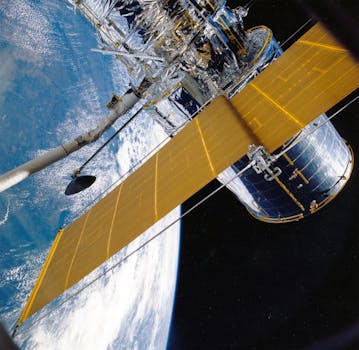
The Future of Satellites: Revolutionizing Global Connectivity and Exploration. The future of satellites is poised to revolutionize global connectivity and exploration, with advancements in space technology and satellite communications. Satellites have been a crucial part of modern life, providing navigation, communication, and weather forecasting services. However, the next generation of satellites is expected to be even more powerful, efficient, and versatile, enabling new applications and services that will transform the way we live and work.
Satellite technology has come a long way since the launch of the first artificial satellite, Sputnik, in 1957. Today, there are thousands of satellites in orbit around the Earth, providing a wide range of services, including television broadcasting, telecommunications, navigation, and weather forecasting. The development of new satellite technologies, such as satellite constellations and high-throughput satellites, is expected to further expand the capabilities of satellites and enable new applications, such as global internet connectivity and Earth observation.
Advancements in Satellite Technology
Several advancements in satellite technology are driving the future of satellites. One of the most significant developments is the use of satellite constellations, which involve launching multiple satellites into orbit to provide global coverage. Satellite constellations offer several advantages over traditional satellites, including improved coverage, increased capacity, and reduced latency. Companies such as SpaceX, OneWeb, and Amazon are investing heavily in satellite constellations, with plans to launch thousands of satellites into orbit in the coming years.
Another significant advancement in satellite technology is the development of high-throughput satellites (HTS). HTS satellites use advanced technologies, such as spot beams and frequency reuse, to increase the capacity of satellites and provide faster data speeds. HTS satellites are expected to play a crucial role in providing global internet connectivity, particularly in underserved and remote areas. The use of HTS satellites is also expected to enable new applications, such as satellite-based broadband and 5G services.
Applications of Future Satellites
The future of satellites is expected to enable a wide range of new applications and services. One of the most significant applications of future satellites is global internet connectivity. Satellite constellations and HTS satellites are expected to provide fast and reliable internet access to underserved and remote areas, bridging the digital divide and enabling new economic opportunities. The use of satellites for internet connectivity is also expected to enable new applications, such as online education, telemedicine, and e-commerce.
Another significant application of future satellites is Earth observation. Satellites are expected to play a crucial role in monitoring the environment, tracking climate change, and predicting natural disasters. The use of satellites for Earth observation is also expected to enable new applications, such as precision agriculture, forestry management, and disaster response. The development of new satellite technologies, such as synthetic aperture radar (SAR) and hyperspectral imaging, is expected to further expand the capabilities of satellites for Earth observation.
Challenges and Opportunities
While the future of satellites is poised to revolutionize global connectivity and exploration, there are several challenges and opportunities that need to be addressed. One of the most significant challenges is the issue of space debris, which poses a significant threat to the sustainability of space activities. The development of new technologies and regulations is necessary to mitigate the risk of space debris and ensure the long-term sustainability of space activities.
Another significant challenge is the issue of cybersecurity, which is becoming increasingly important as satellites become more interconnected and reliant on complex software systems. The development of new cybersecurity technologies and regulations is necessary to protect satellites from cyber threats and ensure the integrity of satellite communications.
Conclusion
In conclusion, the future of satellites is poised to revolutionize global connectivity and exploration, with advancements in space technology and satellite communications. The development of new satellite technologies, such as satellite constellations and HTS satellites, is expected to enable new applications and services, such as global internet connectivity and Earth observation. However, there are several challenges and opportunities that need to be addressed, including the issue of space debris and cybersecurity. As the satellite industry continues to evolve, it is likely that we will see new and innovative applications of satellite technology, driving further growth and development in the years to come.




